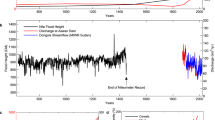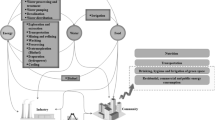Abstract
The Middle East and North Africa (MENA) region stands out globally both for the immensity of its energy resources, and the paucity of its freshwater resources. Most energy extraction and conversion technologies have associated freshwater demand, and in the MENA region these account for 2 % of the available sustainable supply. We examine how this demand could change over the 21st century, assuming growth in population and economic output, and considering three alternative pathways for energy efficiency, carbon intensity, and energy exports from the region. We find that in the pathway marked by improved efficiency, a transition to renewable energy sources, and declining energy exports, water consumption for energy is twice as high as today’s values by the end of the century. By contrast, in the pathway marked by continued commitment to fossil resource extraction, use, and export, water demand for energy might rise by a factor of five. If the region were to maintain high levels of energy exports, but would substitute the export of fossil fuels by an equivalent amount of electricity derived from sunlight, a freshwater volume comparable to the household needs of up to 195 million people could be saved.



Similar content being viewed by others
References
Anze M, Alves RMB, Nascimento CAO (2010) Optimization of water use in oil refinery. http://aiche.confex.com/aiche/2010/webprogrampreliminary/Paper201402.html. Accessed Jan 2012
Battaglini A, Lilliestam J, Haas A, Patt A (2009) Development of SuperSmart Grids for a more efficient utilisation of electricity from renewable sources. J Clean Prod 17(10):911–918
British Petrol (BP) (2013) BP statistical review of world energy. June 2013. http://www.bp.com/content/dam/bp/pdf/statistical-review/statistical_review_of_world_energy_2013.pdf. Accessed Jan 2013
Canada. National Round Table on the Environment and the Economy (NRTEE) (2010) Changing currents. Water sustainability and the future of Canada’s natural resource sectors. http://www.blue-economy.ca/sites/default/files/reports/resource/changing-currents-water-report-eng-1.pdf. Accessed Jun 2012
Canadian Association of Petroleum Producers (CAPP) (2012) Water Us in Canada’s oil sands. http://www.capp.ca/getdoc.aspx?Docid=193756. Accessed Jul 2012
Carillo AMR, Frei C (2009) Water: a key resource in energy production. Energ Policy 37:4303–4312
Centre for Environment and Development for the Arab Region and Europe (CEDARE) (2006) Water conflicts and conflict management mechanisms in the Middle East and North Africa Region. http://water.cedare.int/cedare.int/files15%5CFile2862.pdf. Accessed Jun 2012
Chapagain AK, Hoekstra AY (2004) Water footprints of nations. Vol. 2: appendices. research report series No. 16. http://www.waterfootprint.org/Reports/Report16Vol2.pdf. Accessed Apr 2012
Damerau K, Williges K, Patt AG, Gauché P (2011) Costs of reducing water use of concentrating solar power to sustainable levels: scenarios for North Africa. Energ Policy 39:4391–4398
RCP Database, version 2.0.5 (2009) http://www.iiasa.ac.at/web-apps/tnt/RcpDb. Accessed Jun 2012
Davies EGR, Kyle P, Edmonds JA (2013) An integrated assessment of global and regional water demands for electricity generation to 2095. Adv Water Resour 52:296–313
Argonne National Laboratory (US DOE) (2008) Water issues associated with heavy oil production. http://www.perf.org/images/Archive_HeavyOilReport.pdf . Accessed Mar 2013
Federal Institute for Geosciences and Natural Resources (BGR) (2009) Reserves, Resources and Availability of Energy Resources 2010
Feeley TJ III et al (2007) Water: a critical resource in the thermoelectric power industry. Energy 33:1–11
Food and Agriculture Organization of the United Nations (FAO) (2008) Water for agriculture and energy in Africa. The challenges of climate change. Conference report, Dec 15–17, Sirte Libyan Arab Jamahiriya
Food and Agriculture Organization of the United Nations (FAO). AQUASTAT: FAO’s global information system on water and agriculture. http://www.fao.org/nr/water/aquastat/main/index.stmS. Accessed Mar 2014
Fthenakis V, Kim HC (2010) Life-cycle uses of water in U.S. electricity generation. Renew Sustain Energ Rev 14:2039–2048
Gleick PH (1994) Water and energy. Annu Rev Energy Environ 19:267–299
Griffiths M, Woynillowicz D (2003) Oil and troubled waters. Reducing the impact of the oil and gas industry on Alberta’s water resources. Pembina Insitute for Appropriate Development
Haddadin MJ (2001) Water scarcity impacts and potential conflicts in the MENA region. Water Int 26(4):460–470
Harte J, El-Gasseir M (1978) Energy and water. Science 199:623–634
Hoekstra AY, Mekonnen MM (2012) The water footprint of humanity. Proc Natl Acad Sci 109(9):3232–3237
International Energy Agency (IEA) Energy Technology Systems Analysis Programme (ETSAP) (2010) Unconventional oil and gas production. http://iea-etsap.org/web/HIGHLIGHTS%20PDF/P02-Uncon%20oil&gas-GS-gct%201.pdf. Accessed Mar 2014
International Energy Agency (IEA) Statistics by country (2008). http://www.iea.org/stats/index.asp. Accessed Dec 2012
International Energy Agency (IEA) (2009) World energy outlook. http://www.iea.org/textbase/nppdf/free/2009/weo2009.pdf
IPCC (2013) Climate change 2013: the physical science basis. Contribution of Working Group I to the Fifth Assessment Report of the Intergovernmental Panel on Climate Change [Stocker, T.Fet al. (eds.)]. Cambridge University Press, Cambridge, UK, and New York, NY, USA
Kyle P et al (2013) Influence of climate change mitigation technology on global demands of water for electricity generation. Int J Grennh Gas Control 13:112–123
Levin DB, Pitt L, Love M (2004) Biohydrogen production: prospects and limitations to practical application. Int J Hydrog Energ 29:173–185
Macknick J et al. (2011) A review of operational consumption and withdrawal factors for electricity generating technologies. Technical Report NREL/TP-6A20-50900. http://www.nrel.gov/docs/fy11osti/50900.pdf. Accessed Aug 2014
Macknick J et al (2012) Operational water consumption and withdrawal factors for electricity generating technologies: a review of existing literature. Environ Res Lett 7:045802
MacMahon JE, Price SK (2011) Water and energy internactions. Annu Rev Environ Resour 36:163–191
Messner S, Strubegger M (1995) User’s guide for MESSAGE III. International Institute for Applied Systems Analysis, Laxenburg, WP-95–69
Mielke E, Anadon L, Narayanamurti V (2010) Water consumption of energy resource extraction, processing, and conversion. Energy Technology Innovation Policy Research Group, Belfer Center, Harvard Kennedy School. http://belfercenter.ksg.harvard.edu/files/ETIP-DP-2010-15-final-4.pdf. Accessed Sept 2012
Nakicenovic N, Swart R (2000) Special report on emissions scenarios, International Panel on Climate Change. Cambridge University Press, Cambridge
Naterer GF, Jaber O, Dincer I (2010) Environmental impact comparison of steam methane reformation and thermochemical processes of hydrogen production. In: 18th World Hydrogen Energy Conference 2010 - WHEC 2010 Parallel Sessions Book 3: Hydrogen Production Technologies - Part 2 Proceedings of the WHEC, Stolten D, Grube T (eds.), May 16–21 2010, Essen
National Renal Administrators Association (NRAA) (NN) Food security, water and energy nexus in India. http://nraa.gov.in/FoodSecurityWaterAndEnergyNexus.pdf. Accessed Jan 2012
Owen M (2006) Reduction of water use in wet FGD systems. NETL Project DE-FC26-06NT42726
Pfenninger S et al (2014) Potential for concentrating solar power systems to provide baseload and dispatchable power. Nat Clim Change, published online 06/22/2014
Riahi K, Grübler A, Nakicenovic N (2007) Scenarios of long-term socio-economic and environmental development under climate stabilization. Technol Forecast Soc Chang 74(7):887–935
Rogner HH (1997) An assessment of world hydrocarbon resources. Annu Rev Energy Environ 2:217–262
Siddiqi A, Anadon LD (2011) The water–energy nexus in Middle East and North Africa. Energ Policy 39:4529–4540
Smart A, Aspinall A (2009) Water and the electricity generation industry. Implications of use. Waterlines Report Series No. 18, National Water Commission, Canberra
Smil V (2010) Energy transitions: history, requirements, prospects. Praeger, Santa Barbara, Denver, Oxford
Sovacool BK, Sovacool KE (2009) Identifying future electricity–water tradeoffs in the United States. Energ Policy 37:2763–2773
Sowers J, Vengosh A, Weinthal E (2011) Climate change, water resources and the politics of adaptation in the Middle East and North Africa. Clim Chang 104:599–627
Spath PL, Mann MK (2001) Life cycle assessment of hydrogen production via natural gas steam reforming. NREL Report TP-570-27637. http://www.nrel.gov/docs/fy01osti/27637.pdf. Accessed Nov 2012
Stockholm Environment Institute (SEI) (2011). Understanding the Nexus. Background paper for the Bonn2011 nexus Conference. http://www.water-energy-food.org/documents/understanding_the_nexus.pdf. Accessed Nov 2012
UN DESA (2009) World population prospects: the 2008 Revision database. Working Paper No. ESA/P/WP.210, United Nations Department of Economic and Social Affairs
UN (2010) Population Division, World Population Prospects: The 2010 Revision. http://esa.un.org. Accessed Feb 2013
U.S. Department of Energy (DOE) (2006) Energy Demands on Water Resources. Report to Congress, Washington, DC. /http://www.sandia.gov/energy-water/docs/121-RptToCongress-EWwEIAcomments-FINAL.pdf. Accessed Aug 2012
U.S. Department of Energy (DOE) (2009) Concentrating solar power commercial application study: reducing water consumption of concentrating solar power electricity generation. Report to Congress, Washington DC
Van Vliet OPR, Faaji APC, Turkenburg WC (2009) Fischer–Tropsch diesel production in a well-to-wheel perspective: a carbon, energy flow and cost analysis. Energy Convers Manag 50:855–876
Van Vuuren DP et al (2011) The representative concentration pathways: an overview. Clim Chang 109:5–31
Vassolo S, Döll P (2005) Global-scale gridded estimates of thermoelectric power and manufacturing water use. Water Resour Res 41, W04010
Water Science and Technology Board (WSTB) (2008) Desalination: a national perspective. The National Academy Press, Washington DC
Yang X, Dzieglielewski B (2007) Water use by thermoelectric power plants in the United States. J Am Water Res Assoc 43(1):160–169
Yang CJ, Jackson RB (2012) China’s growing methanol economy and its implications on energy and environment. Energ Policy 41:878–884
Younos T, Hill R, Poole H (2009) Water dependency of energy production and power generation systems. VWRRC Special Report No. SR46-2009
Zhai H, Rubin ES, Versteeg PL (2011) Water use at pulverized coal power plants with postcombustion carbon capture and storage. Environ Sci Technol 45:2479–2485
Acknowledgments
Funding for this work was an internal seed grant for cross-cutting research, the Greenhouse Gas Initiative, from the International Institute for Applied Systems Analysis, Austria, as well as a European Research Council consolidator grant, award number 313553. Any remaining errors of analysis are our own.
Author information
Authors and Affiliations
Corresponding author
Electronic supplementary material
Below is the link to the electronic supplementary material.
ESM 1
(DOC 704 kb)
Rights and permissions
About this article
Cite this article
Damerau, K., van Vliet, O.P.R. & Patt, A.G. Direct impacts of alternative energy scenarios on water demand in the Middle East and North Africa. Climatic Change 130, 171–183 (2015). https://doi.org/10.1007/s10584-015-1345-y
Received:
Accepted:
Published:
Issue Date:
DOI: https://doi.org/10.1007/s10584-015-1345-y




